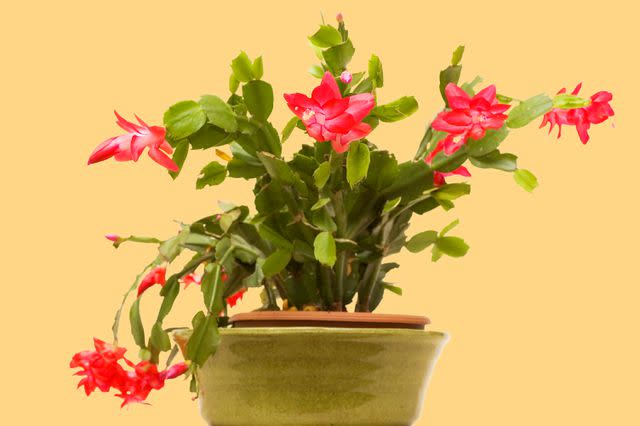How to Care for Christmas Cactus
This winter-flowering houseplant will brighten your interiors during the coldest months of the year.
The wintertime can be devoid of color and signs of life, which makes any winter flowering plant a treat to see. One of the more popular varieties of these plants is the Christmas cactus, which is named for its brightly-colored flowers that bloom around the holiday season. The Christmas cactus is a succulent, usually grown as a houseplant, with flattened stems and bold blooms in red, purple, peach, and white. Native to the coastal mountains of Brazil, Christmas cactus will bring a delightful flair to any indoor space. Below, learn how to care for a Christmas cactus so you can get the most out of these cheery, festive houseplants.

Westhoff/Getty Images
Christmas Cactus Care Tips
Fortunately, Christmas cactus is pretty easy to care for, but you'll want to follow the guidelines below for the best results—and to ensure you get those beautiful blooms in the winter.
Light
Christmas cacti will do best in bright, indirect light. "They prefer filtered sunlight or moderate shade and should be kept away from direct sunlight to prevent leaf scorching," Chad Massura, co-founder of Rosy Soil, says. So, to avoid giving the plant too much sun, don't place a Christmas cactus in a south-facing window. If the leaves of your Christmas cactus are turning red or pink, this may be a sun that it's getting too much sun and needs relocated to a spot with more indirect light.
Soil and Water
Massura says Christmas cacti do best in well-draining potting soil that retains some moisture but doesn’t become waterlogged. (Look for soil that is specifically formulated for cacti or succulents.) When watering, Donna Letier, co-founder and CEO of Gardenuity, says to err on the side of underwatering versus overwatering, since Christmas cactus "tends to tolerate slight underwatering better than excessive moisture."
Letier also notes that Christmas cactus, like most succulents, come with a built-in hydration indicator. "When the plant requires water, the leaves may appear limp or droopy," she says, adding that the frequency of blooming can also give you some signs of how much to water your plant. "If your Christmas cactus has bloomed, it may require additional hydration," she says.
And once you've watered your plant, allow the soil to dry out slightly before the next watering. "It's important not to let the plant sit in standing water, as it can lead to root rot," Letier says. Water your Christmas cactus again when the top inch of the soil feels dry to the touch, Massura advises.
Temperature and Humidity
To keep your Christmas cactus happy and comfortable, keep the surrounding temperatures between 60 F to 75 F. Adding more humidity to the environment can also make the conditions extra suitable for the cacti. "Christmas cacti appreciate higher humidity, which can be achieved through regular misting, placing a tray of water nearby, or purchasing a mini humidifier to increase the room’s humidity," Massura says.
Fertilizer
If your plant has the right soil, Letier says fertilizing isn't necessary to keep Christmas cactus healthy. However, if you do decide to fertilize, Massura says you can do so by adding a handful of worm castings to the soil every four to six weeks. Soil containing biochar, like Rosy Soil's Indoor Potting Mix, helps retain nutrients, which reduces the frequency of fertilization needs, Massura adds.
Potting and Repotting
Massura recommends repotting Christmas cactus every two to three years or when it outgrows its container. "Keep in mind the shallow root system of Christmas cacti when selecting a pot—choose one with proper drainage and only slightly larger than the root ball," he says. "This approach ensures an enriched environment for optimal growth and soil health." Be sure to avoid repotting during the flowering period (which is typically November to January), he adds, to minimize stress on the plant.
Pests and Problems
Christmas cactus is a relatively pest-resistant plant, but it can still be subject to some annoying bug invasions. Spider mites, aphids, mealybugs, scale, and fungus gnats are all common pests that can affect Christmas cactus. Before taking any other steps, make sure to isolate your plant to keep it from infecting other houseplants, and then figure out what pest you're dealing with. Depending on the pest, you may want to use insecticide, replace the potting soil, or wipe down the leaves. Read up on more tips for getting rid of common houseplant pests here.
How to Propagate Christmas Cactus
Propagating Christmas cactus is the gift that keeps on giving. Learn two different ways to propagate the plant here.
Frequently Asked Questions
Are Christmas cactus poisonous to cats and dogs?
The ASPCA lists Christmas cactus as non-toxic to cats and dogs. However, that doesn't mean it's harmless. If your pet only ingests a small amount, then it's probably okay. But if a large amount of the plant is consumed, cats and dogs may experience gastrointestinal distress, such as diarrhea, vomiting, and decreased appetite.
How can you get a Christmas cactus to bloom?
Getting Christmas cactus to bloom is a matter of balancing the water, light, and temperature conditions during the right time of year. Around October, start limiting the water for your plant, which will force the plant to enter the dormancy period. Move your plant to a spot where it receives at least 12 hours of darkness a day, to help it enter a flowering period. Make sure to also keep the plant in a cool-temperature room, around 50 F to 55 F.
For more Real Simple news, make sure to sign up for our newsletter!
Read the original article on Real Simple.

